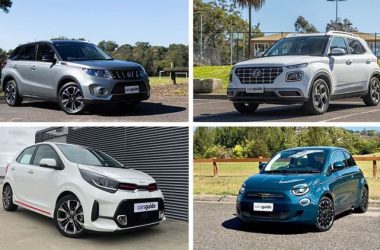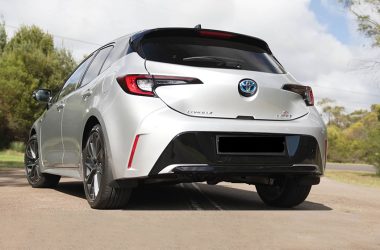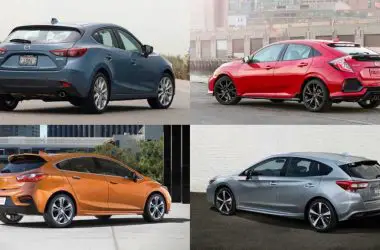What Are Electric Hatchbacks?
Electric hatchbacks are a type of electric vehicle that combines the hatchback body style with an electric powertrain. Hatchbacks are small cars with a rear door that opens upwards to access a cargo area. Electric vehicles (EVs) use one or more electric motors for propulsion, powered by a battery pack that can be recharged by plugging into the electrical grid.
Electric hatchbacks differ from regular internal combustion engine hatchbacks in several ways. The main difference is the powertrain – instead of having an engine powered by gasoline, electric hatchbacks use a battery-powered electric motor. This means electric hatchbacks have no tailpipe emissions. The battery pack stores energy that powers the electric motor and other electrical systems.
Another key difference is that electric hatchbacks require regular charging by plugging into an electrical outlet or charging station. Most can drive 100-250 miles on a full charge, less than a gas-powered car’s range. Recharging the battery pack typically takes several hours. Electric hatchbacks accelerate quickly due to instant torque from the electric motor.
Some of the most popular electric hatchback models include the Nissan Leaf, Chevrolet Bolt EV, Kia Soul EV, Volkswagen e-Golf, and BMW i3. Major automakers continue to expand their electric hatchback offerings as the technology improves. Overall, electric hatchbacks provide a more sustainable and environmentally-friendly alternative to traditional internal combustion engine hatchbacks.
History of Electric Hatchbacks
Electric hatchbacks are a relatively new vehicle category that has origins dating back to the late 1990s and early 2000s. Some key milestones in the history and development of electric hatchbacks include:
In 1997, General Motors launched the first mass production electric car, the EV1 hatchback. It had a range of up to 100 miles on a single charge, demonstrating the viability of a practical electric vehicle.
In 2008, Tesla began delivery of its all-electric Roadster sports car. While not technically a hatchback, it was the first highway-capable all electric car from a major manufacturer in years and helped pave the way for future EVs.
In 2010, major automakers like Nissan and Mitsubishi introduced some of the first affordable electric hatchbacks aimed at mainstream buyers, such as the Nissan Leaf and Mitsubishi i-MiEV.
In 2012, the Renault Zoe was launched. It featured a 22kWh battery pack and had a real world range of about 150km on a single charge. The Zoe helped demonstrate the practicality of compact electric hatchbacks.
By 2020, almost every major automaker had at least one affordable electric hatchback model available, and range and charging speeds were dramatically improving compared to earlier electric hatchback models. This made them more practical replacements for gas-powered hatchbacks.
Benefits of Electric Hatchbacks
One of the main benefits of electric hatchbacks is their reduced emissions compared to traditional gas-powered vehicles. Electric cars produce no direct emissions, which helps improve air quality, especially in urban areas. According to the U.S. Department of Energy, electric vehicles can reduce greenhouse gas emissions by 30-60% compared to gasoline vehicles depending on the electricity source (https://afdc.energy.gov/fuels/electricity_benefits.html).
Electric hatchbacks also provide major fuel cost savings for drivers. Electricity prices are lower than gasoline prices, and electric vehicles are generally more efficient than gas-powered cars. Maintenance costs are also lower since electric motors have fewer moving parts and don’t require oil changes. According to Drive Clean California, fuel costs for electric vehicles are about one-third to one-fourth the cost of gasoline vehicles (https://driveclean.ca.gov/top-reasons).
There are tax incentives and rebates available for purchasing electric vehicles in many areas. For example, there is a federal tax credit of up to $7,500 for buying a new electric vehicle in the U.S. Some states and utilities also offer additional rebates and incentives. This can help reduce the upfront cost of buying an electric hatchback.
Electric hatchbacks also provide performance benefits compared to traditional internal combustion engine vehicles. Their electric motors provide instant torque and smooth acceleration. Regenerative braking recovers energy and reduces wear on the brakes. Electric hatchbacks are usually quieter and provide a smoother ride as well.
Drawbacks of Electric Hatchbacks
While electric hatchbacks provide benefits like lower operating costs and reduced emissions, they also come with some drawbacks compared to gas-powered hatchbacks. Three key drawbacks to consider are:
1. Higher Upfront Costs – Electric hatchbacks typically cost more upfront than similar gas-powered models. The battery pack alone can add $5,000-$10,000 to the price. Even with potential incentives and tax credits, electric hatchbacks usually have a higher initial purchase price.
2. Range Limitations – Most electric hatchbacks have a range of 100-250 miles on a single charge. This range anxiety causes some drivers to worry about running out of charge mid-trip. Gas-powered cars can drive over 300 miles before refueling.
3. Charging Infrastructure – While charging stations are becoming more common, many drivers do not have easy access to public charging stations. At home, installing a high-speed charger often requires electrical upgrades. The lack of ample, convenient charging can make owning an electric vehicle more difficult.
According to https://www.carwow.co.uk/guides/choosing/disadvantages-of-electric-cars, “Range limitations and charging infrastructure worries mean electric cars aren’t yet practical for everyone.” Over time, technology improvements and infrastructure expansion may help address these drawbacks.
Best Electric Hatchbacks
The top rated and most popular electric hatchback models focus on maximizing range and performance while keeping costs relatively affordable. Here are some of the best options on the market today:
The Nissan LEAF is one of the most established electric hatchbacks, offering up to 226 miles of range from its 62 kWh battery pack. Pricing starts around $28,000 for the base model, making it one of the most affordable EVs. The LEAF offers zippy acceleration and good cargo space for its size.
The Chevrolet Bolt EV is another popular, affordable choice, with an EPA estimated range of 259 miles from its 65 kWh battery. The Bolt EV starts around $26,500 and provides quick acceleration and good tech features. Drawbacks include limited cargo space compared to some competitors.
At the higher end, the Hyundai IONIQ Electric offers an EPA estimated 170 miles of range. It starts around $33,500, so it costs more but offers a more premium interior and driving experience compared to budget-friendly picks. The IONIQ Electric delivers brisk acceleration and generous cargo capacity.
Overall the top electric hatchbacks combine everyday usability, good driving range between charges, and accessible pricing. Models like the LEAF, Bolt EV, and IONIQ Electric exemplify the current state of the art for the category.
Electric Hatchback Batteries
Electric hatchbacks use rechargeable lithium-ion batteries to store energy. Lithium-ion batteries are lightweight and energy dense, making them well-suited for electric vehicles. The most common types of lithium-ion batteries used in electric hatchbacks include nickel manganese cobalt oxide (NMC), nickel cobalt aluminum oxide (NCA), and iron phosphate (LFP) chemistries (https://en.wikipedia.org/wiki/Electric_vehicle_battery).
Battery capacity in electric hatchbacks typically ranges from 15-60 kWh. Lower capacity batteries around 15-30 kWh allow driving ranges of 100-150 miles on a single charge, while higher capacity batteries above 50 kWh can provide 200+ miles of range (https://afdc.energy.gov/vehicles/electric_batteries.html). Larger battery packs allow longer driving range but increase weight and cost.
Charging times depend on the charging equipment. Using a standard 120V outlet can take over 24 hours to fully recharge an electric hatchback battery. With a higher voltage 240V Level 2 charger, recharge times are typically 4-8 hours. DC fast charging can charge an electric hatchback battery to 80% in under an hour.
The lifespan of lithium-ion batteries in electric hatchbacks is typically 5-10 years or around 1,000 charge cycles before significant degradation occurs. High temperatures can reduce battery lifespan so electric hatchbacks have cooling systems to maintain optimal temperatures.
Electric Hatchback Charging
There are three main levels of electric vehicle charging – Level 1, Level 2, and DC Fast Charging (referenced as Level 3). Understanding the differences between these is important for electric hatchback owners.
Level 1 charging uses a standard 120V AC plug and takes over 10 hours to fully charge an electric hatchback battery. This is the slowest charging option but requires no additional charging equipment beyond the portable cordset that comes standard with the vehicle. Level 1 charging is best for overnight charging at home when you don’t drive long distances daily.
Level 2 charging requires a 240V AC plug and charger hardware, cutting full charge times down to around 4-6 hours. Most public charging stations are Level 2 and allow you to recharge while running errands. Installation of a Level 2 charger at home significantly reduces charging times compared to Level 1. (EVBox provides a guide to EV charging basics.)
DC Fast Charging, sometimes called Level 3, uses direct current to achieve ultra fast charge times. DC fast charging can add 60-80 miles of range in 15-30 minutes. However, these stations are much less common than Level 1 and Level 2. DC fast charging works best for long road trips when you need to minimize charging time.
Understanding your electric hatchback’s charging options and capabilities is key to a smooth transition to driving electric. You can find electric vehicle charging stations across the country using the Department of Energy’s station locator. (Electric Vehicle Charging Station Locations – U.S. Dept. of Energy)
Electric Hatchback Adoption
Electric hatchback sales have been steadily growing in recent years. According to the International Energy Agency (IEA), global sales of battery electric vehicles increased by 70% in 2022 compared to 2021, with nearly 800,000 sold in the United States alone (IEA). Through the first three quarters of 2023, EV sales in the US surpassed 300,000, putting the market on track to exceed 1 million for the first time (Cox Automotive).
Several factors are driving this growth, including falling battery costs, expanded model availability, government incentives, and rising consumer awareness of EVs. Major automakers are committing billions to electrify their lineups, with some pledging to go all-electric in the coming decades. This influx of new EVs at various price points will continue to make them more accessible.
Most forecasts predict EV adoption rates will accelerate globally. IHS Markit projects EVs will comprise over 30% of new vehicle sales in the US by 2030. EV volumes could grow from 4.2 million in 2020 to 26 million by 2030, according to BloombergNEF. As charging infrastructure expands and prices reach parity with gas vehicles, EVs are expected to achieve mass market status and make up 50-70% of new car sales in leading markets by 2040.
Electric Hatchback Manufacturers
Major automakers around the world have been ramping up production of electric hatchbacks in recent years. Some of the top manufacturers producing electric hatchbacks include:
Tesla – The American automaker is a pioneer in electric vehicles. They produce the Tesla Model 3 hatchback which offers up to 358 miles of range and rapid acceleration.
Nissan – The Japanese brand manufactures the Nissan Leaf, one of the first mainstream and top selling electric hatchbacks. The latest Leaf Plus model provides up to 226 miles of range.
BMW – The German luxury brand offers the sporty BMW i3 hatchback with 153 miles of range. They also have the BMW i3s performance model.
Volkswagen – VW produces the Volkswagen ID.3 hatchback and the ID.4 crossover SUV. The ID.3 hatch provides up to 341 miles of range on a single charge.
Hyundai – The South Korean automaker manufactures the Hyundai Kona Electric subcompact SUV and hatchback. The Kona Electric offers 258 miles of range.
Kia – Sister brand to Hyundai, Kia produces the Niro EV crossover SUV and hatchback. The Niro EV provides 239 miles of range on a single charge.
There are also newer electric vehicle startups entering the hatchback market such as Polestar and Lucid Motors. Major investments continue to pour into electric hatchback development and manufacturing.
Future of Electric Hatchbacks
The future looks bright for electric hatchbacks. Major automakers like Volkswagen, Renault, Nissan, and Honda have plans to release new all-electric hatchback models over the next few years.
Volkswagen is readying the ID.3 hatchback for a 2020 release, representing the automaker’s first ground-up design as an electric vehicle. Early reviews praise the ID.3’s cutting edge design and up to 340 miles of range on a single charge (Source).
Renault plans to launch the Morphoz concept hatchback by 2025, featuring adjustable wheelbases and battery pack sizes to accommodate different range needs. The Morphoz can travel nearly 500 miles on a full charge in its long-range configuration (Source).
Several other major automakers have announced upcoming electric hatchbacks over the next few years, including Peugeot, Honda, Mercedes-Benz, and BMW. Industry analysts predict strong growth for the electric hatchback segment as battery costs decrease and charging infrastructure expands globally.
Beyond new models, electric hatchbacks are poised to benefit from advances in battery technology that will enable longer ranges and faster charging times. Solid state batteries being developed by several companies could allow hatchbacks to charge to 80% in under 15 minutes in the next 5-10 years (Source). Lighter, denser batteries will also allow hatchbacks to travel farther without needing larger, heavier battery packs.
With exciting new models and continued innovation in battery tech on the horizon, the future looks very promising for electric hatchbacks to gain significant market share globally in the 2020s and beyond.





